Develop Queries Based on Booking Supplement and Consume on SAP Analytics Cloud
- How to create an analytical query based on booking supplement as CDS View Entities
- How to connect an ABAP System to SAP Analytics Cloud
- How to consume analytical queries on SAP Analytics Cloud by creating models and stories
Prerequisites
- You need the standard developer authorization profile to create ABAP development objects.
- You need a SAP Analytics Cloud account.
- Install
ABAPGitPlugin in ADT. See http://eclipse.abapgit.org/updatesite/ - To get the Flight Model into the system, follow the description at https://github.com/SAP/abap-platform-refscen-flight/blob/master/README.md
- Requires Customer or Partner License.
- You can find an intermediate tutorial for SAP Analytics Cloud here https://developers.sap.com/tutorials/abap-environment-analytics.html.
Always replace #### with your initials or group number.
- Step 1
The new RAP based InA service exposure enables the SAP Business Technology Platform ABAP Environment developers to develop analytical queries(based on ABAP-CDS analytical data models) and expose them via the
InA(Information Access) service protocol. In this Tutorial you will create a complete Analytical Data Model for Booking data. This consists out of dimensions for Carrier, Customer, Connection and Agency data, as well as an interface CDS view for Booking data which acts as a data source for the cube and query.
These analytical queries can be further consumed in the SAP Analytics cloud to create analytical models, stories, multi-dimensional reports and more.
- Step 2
As a first task you will start to import templates that you will use in this tutorial to create Analytical CDS views such as dimension views, cubes and queries.
The templates already contain certain annotations that are mandatory for the above mentioned analytical CDS views. If values such as the name of a property have to be added this can then simply be done by using code completion.
-
Click on the following link to display the file analytical_templates.xml. Templates
-
Right-click on the browser window and save the content as an xml-file called analytical_templates.xml.

-
Open ADT. In the menu choose Window > Preferences.

-
In the Templates dialogue choose Import.

-
Select the XML file analytical_templates.xml that you have saved.

The Import-Dialog only allows to select files having the extension
.xml.When you have downloaded the file using a different file extension you have first to rename your file so that it gets the extension.xml. -
You will see that three new templates have been imported that you will use in the following tutorial.
Press Apply and Close

-
- Step 3
Dimensions views are links to various master data, which are later used in reporting as further attributes (according to which different aggregations can be made) and thus make up the versatility of our Analytical Model.
In the following you will create seven dimension views for Travel Agencies, Carrier, Customers, Connections, Airport, Booking and Supplements so that you can visualize our measures Quantity, Sales and Average Sales in relation to these dimensions.
-
Open ADT and login to your ABAP System.
If you do not have a package, create a new one. -
Right-click your package and choose New > Other ABAP Repository Object.

-
Choose Core Data Services > Data Definition and click Next.

-
Enter the following values
- Name:
ZRAP500_I_Agency_#### - Description:
Dimension for Agencies - Referenced Object:
/dmo/agency
and click Next.
By selecting a table or another CDS view as Referenced object the wizard will use this object as a data source for the new CDS view and it will automatically add all fields into the DDL source code and it will also create camel Case aliases if needed.

- Name:
-
Choose a transport request and click Next.
Do NOT press Finish, because otherwise the wizard will not provide us the option to choose a specific template but would choose the template that you have used the last time.

-
In the Templates dialogue choose the Define a View Entity for a Dimension and press Finish. The Define a View Entity for a Dimension template is one of the new data definition templates that you have imported in the last step. This template contains certain annotations which will be explained below that are mandatory for dimension views.

-
- Step 4
-
Now you need to edit the dimension view. Here you can use code completion to add the values for the annotations
@ObjectModel.representativeKey
and
@ObjectModel.text.element
that are needed for our dimension view.

-
Click on
representativeKey, delete the placeholderrepresentativKeyso that you get an empty string ’’ , press CTRL + Space and chooseAgencyID.
You defineAgencyIDas the representative key to be able to refer to it using@ObjectModel.foreignKey.association
-
Click on
textElement, delete the placeholder stringtextElement, press CTRL + Space and choose Name.
You state that attribute Name contains the text element for a given
AgencyId. With that, you can deliver texts in our analytical query using annotation'@AnalyticsDetails.query.display: #TEXT'on attributeAgencyIdand it is not necessary to expose attribute name separately via the query to show the name of an agency. -
To make
@ObjectModel.text.element: ['Name']work, you need to annotate the attribute Name as being text via@Semantics.text: true
-
Build an association to
I_Countryto be able to retrieve associated texts (country names). Add this association in your code:` association [1] to I_Country as _Country on Agency.country_code = _Country.Country `
Add as Agency to the define view entity line, to avoid any syntax error:
define view entity ZRAP500_I_Agency_#### as select from /dmo/agency as Agency -
Define a
foreignKey associationviaCountryCode(therepresentative keyofI_Country) to be able to fetch and expose country information (ID and text) asAgencyCountryin the cube and in the query.
-
You expose the Country association to be able to access country information in the cube and query.

-
Remove these fields because they are too long for our analytics scenarios
// email_address as EmailAddress, // web_address as WebAddress -
Change @AccessControl.authorizationCheck: from
#CHECKto#NOT_REQUIRED. -
Save and activate the dimension.

-
Your final code should look like following:
ZRAP500_I_AGENCY_####Copy@AccessControl.authorizationCheck: #NOT_REQUIRED @EndUserText.label: 'dimension for Agency' @Metadata.ignorePropagatedAnnotations: true @Analytics.dataCategory: #DIMENSION @Analytics.internalName: #LOCAL @ObjectModel.representativeKey: 'AgencyID' define view entity ZRAP500_I_Agency_#### as select from /dmo/agency as Agency association [1] to I_Country as _Country on Agency.country_code = _Country.Country { @ObjectModel.text.element: ['Name'] key agency_id as AgencyId, @Semantics.text: true name as Name, street as Street, postal_code as PostalCode, city as City, @ObjectModel.foreignKey.association: '_Country' country_code as CountryCode, phone_number as PhoneNumber, /*Associations*/ _Country }
-
- Step 5
-
Right click Data Definition > New Data Definition. Enter following values and press Next:
- Name:
ZRAP500_I_Airport_#### - Description:
Dimension for Airport - Referenced Object:
/dmo/airport

- Name:
-
Select a transport request and press Next.
- Select again the template Define a View Entity for Dimension and press Finish.
- Choose the property
AirportIdfor the annotation @ObjectModel.representativeKey and chooseNamefor the annotation @ObjectModel.text.element.
-
The same mechanisms are implemented as with dimension Agency, i.e.,
- modeling a dimension with a representative key
- denoting and exposing a text element Name
- modeling and exposing an association to
I_Country
-
Change @AccessControl.authorizationCheck: from
#CHECKto#NOT_REQUIRED. -
Save and activate the dimension.

-
Your final code should look like following:
ZRAP500_I_Airport_####Copy@AbapCatalog.viewEnhancementCategory: [#NONE] @AccessControl.authorizationCheck: #NOT_REQUIRED @EndUserText.label: 'Airport Dimension' @Metadata.ignorePropagatedAnnotations: true @Analytics.dataCategory: #DIMENSION @ObjectModel.representativeKey: 'AirportId' define view entity ZCM_I_Airport as select from /dmo/airport as Airport association [1] to I_Country as _Country on Airport.country = _Country.Country { @ObjectModel.text.element: ['Name'] key airport_id as AirportId, @Semantics.text: true name as Name, city as City, @ObjectModel.foreignKey.association: '_Country' country as Country, /*Associations*/ _Country }
-
- Step 6
-
Right click Data Definition > New Data Definition. Enter following values and press Next:
- Name:
ZRAP500_I_Carrier_#### - Description:
Dimension for Carrier - Referenced Object:
/dmo/carrier
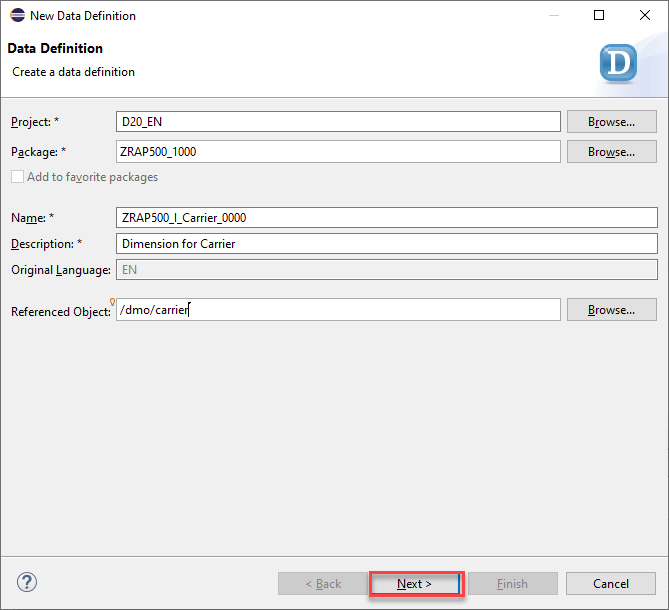
- Name:
-
Select a transport request and press Next.
- Select again the template Define a View Entity for Dimension and press Finish.
- Choose the property
CarrierIdfor the annotation @ObjectModel.representativeKey and chooseNamefor the annotation @ObjectModel.text.element.
-
The same mechanisms are implemented as with dimension Agency and Airport except that we do not expose any other association, i.e.,
- modeling a dimension with a representative key
- denoting and exposing a text element Name
-
Change @AccessControl.authorizationCheck: from
#CHECKto#NOT_REQUIRED. -
Save and activate the dimension.

-
Your final code should look like following:
ZRAP500_I_Carrier_####Copy@AbapCatalog.viewEnhancementCategory: [#NONE] @AccessControl.authorizationCheck: #NOT_REQUIRED @EndUserText.label: 'Carrier View - CDS View Entity Model' @Metadata.ignorePropagatedAnnotations: true @Analytics.dataCategory: #DIMENSION @ObjectModel.representativeKey: 'CarrierId' define view entity ZCM_I_Carrier as select from /dmo/carrier as Carrier { @ObjectModel.text.element: ['name'] key carrier_id as CarrierId, @Semantics.text: true name as Name }
-
- Step 7
-
Right click Data Definition > New Data Definition. Enter following values and press Next:
- Name:
ZRAP500_I_Booking_#### - Description:
Dimension for Booking - Referenced Object:
/dmo/booking

- Name:
-
Select a transport request and press Next.
- Select again the template Define a View Entity for Dimension and press Finish.
- Choose the property
BookingIdfor the annotation @ObjectModel.representativeKey. - You need to define and expose a foreign Key for
TravelIdbecause analytics needs a foreign key relationship on the key attributeTravelId.- Define the association
association [1..1] to /DMO/I_Travel_U as _Travel on $projection.TravelId = _Travel.TravelID. - Remove the @ObjectModel.text.element annotation and add the annotation @ObjectModel.foreignKey.association:
_Travelon the top oftravel_idkey.
- Define the association
-
Although
/dmo/bookingcontains more information, we just exposeBookingDateandFlightDatehere. Other interesting attributes (Customer, Carrier, Connection) are exposed via their own dimension views. The other potential measure attributeFlightPriceis not used in this tutorial (because we analyze Booking Supplements).
Remove this lines of code:
// customer_id as CustomerId, // carrier_id as CarrierId, // connection_id as ConnectionId, // flight_price as FlightPrice, // currency_code as CurrencyCode,
-
Add annotations to
BookingDateandFlightDate:@EndUserText.label: 'Booking Date'
and
@EndUserText.label: 'Flight Date' -
Change @AccessControl.authorizationCheck: from
#CHECKto#NOT_REQUIRED. -
Save and activate the dimension.

-
Your final code should look like following:
ZRAP500_I_BOOKING_####Copy@AbapCatalog.viewEnhancementCategory: [#NONE] @AccessControl.authorizationCheck: #NOT_REQUIRED @EndUserText.label: 'Booking View - CDS View Entity Model' @Metadata.ignorePropagatedAnnotations: true @Analytics.dataCategory: #DIMENSION @ObjectModel.representativeKey: 'BookingId' define view entity ZCM_I_Booking as select from /dmo/booking as Booking association [1..1] to /DMO/I_Travel_U as _Travel on $projection.TravelId = _Travel.TravelID { @ObjectModel.foreignKey.association: '_Travel' key travel_id as TravelId, key booking_id as BookingId, @EndUserText.label: 'Booking Date' booking_date as BookingDate, @EndUserText.label: 'Flight Date' flight_date as FlightDate, /* Associations */ _Travel }
-
- Step 8
- Right click on the folder Data Definitions > New > Data Definition.
- Enter the following values and press Next.
- Name:
ZRAP500_I_Connection_#### - Description:
Dimension for Connections - Referenced Object:
/dmo/connection

- Name:
-
Select a transport request and press Next.
- Select again the template Define a View Entity for Dimension and press Finish.
- Choose the property
connectionIdfor the annotation @ObjectModel.representativeKey. - Add three associations for
_Carrier,_DepartureAirportand_DestinationAirport:association [1] to ZRAP500_I_Carrier_#### as _Carrier on $projection.CarrierId = _Carrier.CarrierId association [1..1] to ZRAP500_I_Airport_#### as _DepartureAirport on $projection.DepartureAirportId = _DepartureAirport.AirportId association [1..1] to ZRAP500_I_Airport_#### as _DestinationAirport on $projection.DestinationAirportId = _DestinationAirport.AirportId
and expose them in the field list by adding
_Carrier,_DepartureAirportand_DestinationAirport
The Connection dimension shall expose attributes around departure and destination locations. It therefore references the same dimension Airport twice, as Departure Airport and as Destination Airport.
-
Add the following annotation to the key field
CarrierId@ObjectModel.foreignKey.association: '_Carrier' -
Add two annotations
@EndUserText.label: 'Departure Airport'and@ObjectModel.foreignKey.association: '_DepartureAirport'to the fieldairport_from_id as AirportFromIdto referring to theAirportIdof the departure airport to expose the ID and text of the airport. You can changeAirportFromIdtoDepartureAirportId. -
Add two annotations
@EndUserText.label: 'Destination Airport'and@ObjectModel.foreignKey.association: '_DestinationAirport'to the fieldairport_to_id as AirportToIdto referring to theAirportIdof the destination airport to expose the ID and text of the airport. You can changeAirportToIdtoDestinationAirportId. -
Add @EndUserText.label: annotations for
DepartureTimeandArrivalTime. -
Remove these two elements because we do not need them:
connection.distance as Distance, connection.distance_unit as DistanceUnit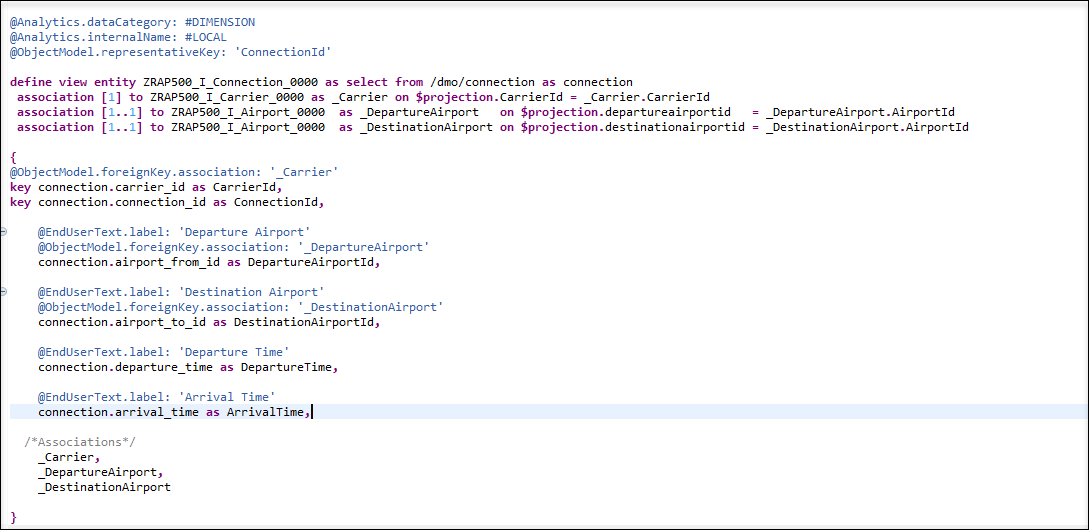
-
Add
DepartureCity,DepartureCountry,DestinationCityandDestinationCountrywith @EndUserText.label: annotation and expose them in the field list by adding_DepartureAirport._Country as _DepartureCountryand_DestinationAirport._Country as _DestinationCountry -
Change @AccessControl.authorizationCheck: from
#CHECKto#NOT_REQUIRED. - Save and activate the dimension view.
-
Your final code should look like the following:
ZRAP500_I_Connection_####Copy
@AccessControl.authorizationCheck: #NOT_REQUIRED @EndUserText.label: 'Dimension for Connections' @Metadata.ignorePropagatedAnnotations: true @Analytics.dataCategory: #DIMENSION @Analytics.internalName: #LOCAL @ObjectModel.representativeKey: 'ConnectionId' define view entity ZRAP500_I_Connection_#### as select from /dmo/connection as connection association [1] to ZRAP500_I_Carrier_#### as _Carrier on $projection.CarrierId = _Carrier.CarrierId association [1..1] to ZRAP500_I_Airport_#### as _DepartureAirport on $projection.DepartureAirportId = _DepartureAirport.AirportId association [1..1] to ZRAP500_I_Airport_#### as _DestinationAirport on $projection.DestinationAirportId = _DestinationAirport.AirportId { @ObjectModel.foreignKey.association: '_Carrier' key connection.carrier_id as CarrierId, key connection.connection_id as ConnectionId, @EndUserText.label: 'Departure Airport' @ObjectModel.foreignKey.association: '_DepartureAirport' connection.airport_from_id as DepartureAirportId, @EndUserText.label: 'Departure City' _DepartureAirport.City as DepartureCity, @EndUserText.label: 'Departure Country' @ObjectModel.foreignKey.association: '_DepartureCountry' _DepartureAirport.Country as DepartureCountry, @EndUserText.label: 'Destination Airport' @ObjectModel.foreignKey.association: '_DestinationAirport' connection.airport_to_id as DestinationAirportId, @EndUserText.label: 'Destination City' _DestinationAirport.City as DestinationCity, @EndUserText.label: 'Destination Country' _DestinationAirport.Country as DestinationCountry, @EndUserText.label: 'Departure Time' connection.departure_time as DepartureTime, @EndUserText.label: 'Arrival Time' connection.arrival_time as ArrivalTime, /*Associations*/ _Carrier, _DepartureAirport, _DepartureAirport._Country as _DepartureCountry, _DestinationAirport, _DestinationAirport._Country as _DestinationCountry }
- Step 9
- Right click on the folder Data Definitions > New > Data Definition.
- Enter the following values and press Next.
- Name:
ZRAP500_I_Customer_#### - Description:
Dimension for Customer - Referenced Object:
/dmo/customers

- Name:
- Select a transport request and press Next.
- Select again the template Define a View Entity for Dimension and press Finish.
- Choose the property
CustomerIdfor the annotation @ObjectModel.representativeKey. - Remove all elements and insert them again with pressing CTRL + Space > Insert All Elements. Because you have used a select from
/dmo/customer as Customerand your elements will be inserted withCustomer. - Add an associations for
_Country:
association [1] to I_Country as _Country on Customer.country_code = _Country.Country
and expose it in the field list by adding
_Country. -
Choose
CustomerNamefor the annotation @ObjectModel.text.element and defineCustomerNamewith first name and last name:
-
Add annotation the following annotation to the
CountryCode:@ObjectModel.foreignKey.association: '_Country'
-
Remove all these elements because they are too much for your analytics case:
Customer.title as Title, Customer.email_address as EmailAddress, Customer.createdby as Createdby, Customer.createdat as Createdat, Customer.lastchangedby as Lastchangedby, Customer.lastchangedat as Lastchangedat, -
Change @AccessControl.authorizationCheck: from
#CHECKto#NOT_REQUIRED. - Save and activate the dimension view.
-
Your final code should look like the following:
ZRAP500_I_Customer_####Copy@AccessControl.authorizationCheck: #NOT_REQUIRED @EndUserText.label: 'Dimension for Customer' @Metadata.ignorePropagatedAnnotations: true @Analytics.dataCategory: #DIMENSION @Analytics.internalName: #LOCAL @ObjectModel.representativeKey: 'CustomerId' define view entity ZRAP500_I_Customer_#### as select from /dmo/customer as Customer association [1] to I_Country as _Country on Customer.country_code = _Country.Country { @ObjectModel.text.element: ['CustomerName'] key Customer.customer_id as CustomerId, Customer.first_name as FirstName, Customer.last_name as LastName, @Semantics.text: true concat_with_space(first_name, last_name, 1) as CustomerName, Customer.street as Street, Customer.postal_code as PostalCode, Customer.city as City, @ObjectModel.foreignKey.association: '_Country' Customer.country_code as CountryCode, Customer.phone_number as PhoneNumber, /*Associations*/ _Country }
- Step 10
- Right click on the folder Data Definitions > New > Data Definition.
- Enter the following values and press Next.
- Name:
ZRAP500_I_Supplement_#### - Description:
Dimension for Supplement - Referenced Object:
/dmo/supplement

- Name:
-
Select a transport request and press Next.
- Select again the template Define a View Entity for Dimension and press Finish.
- Choose the property
SupplementIdfor the annotation @ObjectModel.representativeKey. - Add an associations for
_SupplText:
association [1..*] to ZRAP500_I_SUPPTEXT_#### as _SupplText on $projection.SupplementId = _SupplText.SupplementId
and expose it in the field list by adding
_SupplText. - Choose
_SupplTextfor the annotation @ObjectModel.text.association. - Remove price and currency elements.
- Change @AccessControl.authorizationCheck: from
#CHECKto#NOT_REQUIRED. - Remove all these elements because they are too much for your analytics case:
supplement_category as SupplementCategory, local_created_by as LocalCreatedBy, local_created_at as LocalCreatedAt, local_last_changed_by as LocalLastChangedBy, local_last_changed_at as LocalLastChangedAt, last_changed_at as LastChangedAt, -
Change @AccessControl.authorizationCheck: from
#CHECKto#NOT_REQUIRED. - Save and activate the dimension view. You will have an error that
SupplementTextis not exist, you need to create it in the next step. -
Your final code should look like the following:
ZRAP500_I_Supplement_####Copy@AccessControl.authorizationCheck: #NOT_REQUIRED @EndUserText.label: 'Dimension for Supplement' @Metadata.ignorePropagatedAnnotations: true @Analytics.dataCategory: #DIMENSION @Analytics.internalName: #LOCAL @ObjectModel.representativeKey: 'SupplementId' define view entity ZRAP500_I_Supplement_#### as select from /dmo/supplement association [1..*] to ZRAP500_I_SUPPTEXT_#### as _SupplText on $projection.SupplementId = _SupplText.SupplementId { @ObjectModel.text.association: '_SupplText' key supplement_id as SupplementId, /* Associations */ _SupplText }
- Step 11
- Right click on the folder Data Definitions > New > Data Definition.
- Enter the following values and press Next.
- Name:
ZRAP500_I_SuppText_#### - Description:
Supplement Text view - Referenced Object:
/dmo/suppl_text

- Name:
-
Select a transport request and press Next.
- Select the template Define View Entity and press Finish.

-
Add two annotations for data category and representative key:
@ObjectModel.dataCategory: #TEXT @ObjectModel.representativeKey: 'SupplementId' -
Add another two annotations to
LanguageCodeand Description:
@Semantics.language:true
@Semantics.text:true -
Change @AccessControl.authorizationCheck: from
#CHECKto#NOT_REQUIRED -
Save and activate the dimension view.
-
Do not forget to activate your
ZRAP500_I_Supplement_####dimension to solve the error in the last step. -
Your final code should look like the following:
ZRAP500_I_SuppText_####Copy@AbapCatalog.viewEnhancementCategory: [#NONE] @AccessControl.authorizationCheck: #NOT_REQUIRED @EndUserText.label: 'Supplement Text view' @Metadata.ignorePropagatedAnnotations: true @ObjectModel.usageType:{ serviceQuality: #X, sizeCategory: #S, dataClass: #MIXED } @ObjectModel.dataCategory: #TEXT @ObjectModel.representativeKey: 'SupplementId' define view entity ZRAP500_I_SUPPTEXT_#### as select from /dmo/suppl_text as SupplText { key supplement_id as SupplementId, @Semantics.language:true key language_code as LanguageCode, @Semantics.text:true description as Description }
- Step 12
You need to create a helper interface view to expose the necessary elements from
/dmo/book_supplas well as from associated Travel and Booking views. The cube is based on this view.- Right click on the folder Data Definitions > New > Data Definition.
- Enter the following values and press Next.
- Name:
ZRAP500_I_BookingSupplmnt_#### - Description:
Booking Supplement - Referenced Object:
/dmo/book_suppl

- Name:
-
Select a transport request and press Next.
- Select the template Define View Entity and press Finish.
- Define associations to retrieve
CustomerId,AgencyId(Travel) andCarrierId,ConnectionId(Booking) information.Add two annotations:
association [1..1] to /dmo/travel as _Travel on $projection.TravelId = _Travel.travel_id association [1..1] to /dmo/booking as _Booking on $projection.TravelId = _Booking.travel_id and $projection.BookingId = _Booking.booking_id -
Define the sales per booked supplement based on the price of the supplement (with currency code annotation).
Add annotation @Semantics.amount.currencyCode: to the
currencyCodefield.Currency conversion will be defined in the query.
-
Change @AccessControl.authorizationCheck: from
#CHECKto#NOT_REQUIRED -
Save and activate the dimension view.
-
Your final code should look like the following:
ZRAP500_I_BookingSupplmnt_####Copy@AbapCatalog.viewEnhancementCategory: [#NONE] @AccessControl.authorizationCheck: #NOT_REQUIRED @EndUserText.label: 'Booking Supplement' @Metadata.ignorePropagatedAnnotations: true @ObjectModel.usageType:{ serviceQuality: #X, sizeCategory: #S, dataClass: #MIXED } @ObjectModel.representativeKey: 'BookingSupplementId' define view entity ZRAP500_I_BookingSupplmnt_#### as select from /dmo/book_suppl as BSupplement association [1..1] to /dmo/travel as _Travel on $projection.TravelId = _Travel.travel_id association [1..1] to /dmo/booking as _Booking on $projection.TravelId = _Booking.travel_id and $projection.BookingId = _Booking.booking_id { key travel_id as TravelId, key booking_id as BookingId, key booking_supplement_id as BookingSupplementId, supplement_id as SupplementId, _Travel.customer_id as CustomerId, _Travel.agency_id as AgencyId, _Booking.carrier_id as CarrierId, _Booking.connection_id as ConnectionId, @Semantics.amount.currencyCode: 'CurrencyCode' price as Sales, currency_code as CurrencyCode, /* Associations */ _Travel, _Booking }
- Step 13
The Cube is the analytical interface view that is ultimately used in the query and holds the model together. In addition to the facts and the measurable key figures (if necessary also calculations), it contains references to the dimensions.
- Right click on the folder Data Definitions > New > Data Definition.
- Enter the following values and press Next.
- Name:
ZRAP500_I_SupplCube_#### - Description:
Booking Supplement Cube - Referenced Object:
ZRAP500_I_BookingSupplmnt_####(your booking supplement interface)

- Name:
-
Select a transport request and press Next.
- Select the template Define a View Entity for cube and press Finish.

-
Your created booking supplement interface is implemented in this cube, add as
BSupplementin this line:define view entity ZRAP500_I_SuppCube_#### as select from ZRAP500_I_BookingSupplmnt_#### as BSupplenment
-
You can separate keys, dimensions and measures.

-
Add the following associations
associationsCopy
association [1..1] to ZRAP500_I_Supplement_#### as _Supplement on $projection.SupplementId = _Supplement.SupplementId association [1..1] to ZRAP500_I_Customer_#### as _Customer on $projection.CustomerId = _Customer.CustomerId association [1..1] to ZRAP500_I_Agency_#### as _Agency on $projection.AgencyId = _Agency.AgencyId association [1..1] to ZRAP500_I_Booking_#### as _Booking on $projection.BookingId = _Booking.BookingId and $projection.TravelId = _Booking.TravelId association [1..1] to ZRAP500_I_Connection_#### as _Connection on $projection.CarrierId = _Connection.CarrierId and $projection.ConnectionId = _Connection.ConnectionId association [1..1] to ZRAP500_I_Carrier_#### as _Carrier on $projection.CarrierId = _Carrier.CarrierIdyou also need to add the following entries to the field list
_Agency,
_Booking,
_Supplement,
_Customer,
_Connection,
_Carrier

-
In the created cube you define
foreignKey associationsvia_Supplement,_Customer,_Agency,_AgencyCountry,_Carrierand_Connectionto be able to fetch and expose information in the cube and in the query. And you need to provide an end user text label.- Add the annotation
@ObjectModel.foreignKey.association: '_Supplement'and@EndUserText.label: 'Product'to the fieldSupplementId - Add the annotation
@ObjectModel.foreignKey.association: '_Customer'and@EndUserText.label: 'Customer'to the fieldCustomerId - Add the annotation
@ObjectModel.foreignKey.association: '_Agency'and@EndUserText.label: 'Agency'to the fieldAgencyID - Add the annotation
@ObjectModel.foreignKey.association: '_Carrier'and@EndUserText.label: 'Carrier'to the fieldCarrierId - Add the annotation
@ObjectModel.foreignKey.association: '_Connection'to the fieldConnectionId

- Add the annotation
-
Now you need to expose other attributes like booking date, flight date, departure and destination Country, departure and destination Airport, etc. Add these attributes with all needed annotations:
@EndUserText.label: 'AgencyCountry' @ObjectModel.foreignKey.association: '_AgencyCountry' _Agency.CountryCode as AgencyCountry, @EndUserText.label: 'Booking Date' _Booking.BookingDate as BookingDate, @EndUserText.label: 'Flight Date' _Booking.FlightDate as FlightDate, @EndUserText.label: 'Departure Airport' @ObjectModel.foreignKey.association: '_DepartureAirport' _Connection.DepartureAirportId as DepartureAirport, @EndUserText.label: 'Departure Country' @ObjectModel.foreignKey.association: '_DepartureCountry' _Connection.DepartureCountry as DepartureCountry, @EndUserText.label: 'Destination Airport' @ObjectModel.foreignKey.association: '_DestinationAirport' _Connection.DestinationAirportId as DestinationAirport, @EndUserText.label: 'Destination Country' @ObjectModel.foreignKey.association: '_DestinationCountry' _Connection.DestinationCountry as DestinationCountry,and expose them all in the field list by adding them in the field list:
_Agency._Country as _AgencyCountry, _Connection._DepartureAirport as _DepartureAirport, _Connection._DepartureCountry as _DepartureCountry, _Connection._DestinationAirport as _DestinationAirport, _Connection._DestinationCountry as _DestinationCountry,

-
You need to add some annotations to your measures:
@Semantics.amount.currencyCode: 'CurrencyCode' @Aggregation.default: #SUM Sales, CurrencyCode, @EndUserText.label: 'Quantity' @Aggregation.default: #SUM cast ( 1 as abap.int8 ) as Quantity, - Change @AccessControl.authorizationCheck: from
#CHECKto#NOT_REQUIRED -
Save and activate the dimension view.
-
Your final code should look like the following:
ZRAP500_I_SupplCube_####Copy
@AccessControl.authorizationCheck: #NOT_REQUIRED @EndUserText.label: 'Booking Supplement cube' @Metadata.ignorePropagatedAnnotations: true @Analytics.dataCategory: #CUBE @Analytics.internalName: #LOCAL define view entity ZRAP500_I_SupplCube_0000 as select from ZRAP500_I_BookingSupplmnt_0000 as BSupplenment association [1..1] to ZRAP500_I_Supplement_0000 as _Supplement on $projection.SupplementId = _Supplement.SupplementId association [1..1] to ZRAP500_I_Customer_0000 as _Customer on $projection.CustomerId = _Customer.CustomerId association [1..1] to ZRAP500_I_Agency_0000 as _Agency on $projection.AgencyId = _Agency.AgencyId association [1..1] to ZRAP500_I_Booking_0000 as _Booking on $projection.BookingId = _Booking.BookingId and $projection.TravelId = _Booking.TravelId association [1..1] to ZRAP500_I_Connection_0000 as _Connection on $projection.CarrierId = _Connection.CarrierId and $projection.ConnectionId = _Connection.ConnectionId association [1..1] to ZRAP500_I_Carrier_0000 as _Carrier on $projection.CarrierId = _Carrier.CarrierId { /* keys */ key TravelId, key BookingId, key BookingSupplementId, /* dimensions */ @EndUserText.label: 'Product' @ObjectModel.foreignKey.association: '_Supplement' SupplementId, @EndUserText.label: 'Customer' @ObjectModel.foreignKey.association: '_Customer' CustomerId, @EndUserText.label: 'Agency' @ObjectModel.foreignKey.association: '_Agency' AgencyId, @EndUserText.label: 'AgencyCountry' @ObjectModel.foreignKey.association: '_AgencyCountry' _Agency.CountryCode as AgencyCountry, @EndUserText.label: 'Carrier' @ObjectModel.foreignKey.association: '_Carrier' CarrierId, @ObjectModel.foreignKey.association: '_Connection' ConnectionId, @EndUserText.label: 'Booking Date' _Booking.BookingDate as BookingDate, @EndUserText.label: 'Flight Date' _Booking.FlightDate as FlightDate, @EndUserText.label: 'Departure Airport' @ObjectModel.foreignKey.association: '_DepartureAirport' _Connection.DepartureAirportId as DepartureAirport, @EndUserText.label: 'Departure Country' @ObjectModel.foreignKey.association: '_DepartureCountry' _Connection.DepartureCountry as DepartureCountry, @EndUserText.label: 'Destination Airport' @ObjectModel.foreignKey.association: '_DestinationAirport' _Connection.DestinationAirportId as DestinationAirport, @EndUserText.label: 'Destination Country' @ObjectModel.foreignKey.association: '_DestinationCountry' _Connection.DestinationCountry as DestinationCountry, /* Measures */ @Semantics.amount.currencyCode: 'CurrencyCode' @Aggregation.default: #SUM Sales, CurrencyCode, @EndUserText.label: 'Quantity' @Aggregation.default: #SUM cast ( 1 as abap.int8 ) as Quantity, /* Associations */ _Agency, _Agency._Country as _AgencyCountry, _Booking, _Supplement, _Customer, _Travel, _Connection, _Connection._DepartureAirport as _DepartureAirport, _Connection._DepartureCountry as _DepartureCountry, _Connection._DestinationAirport as _DestinationAirport, _Connection._DestinationCountry as _DestinationCountry, _Carrier }
- Step 14
Since a query belongs to the projection layer (formerly known as consumption layer) it must have a C in its name according to the naming convention used in the Virtual Data Model (VDM) used in SAP S/4HANA. To create a query, there is a mandatory header annotation: @Analytics.query: true
Again you can use a template that you have imported at the beginning of this tutorial.
- Right click on the folder Data Definitions > New > Data Definition.
- Enter the following values and press Next.
- Name:
ZRAP500_C_SuppQuery_#### - Description:
Booking Supplement Query - Referenced Object:
ZRAP500_I_SuppCube_####(your created cube)

- Name:
-
Select a transport request and press Next.
- Select the template Define a View Entity for Query and press Finish.

-
Change @AccessControl.authorizationCheck: from
#CHECKto#PRIVILEGED_ONLY. It only allows privileged access to this query to avoid that it is queried from regular ABAP programs. Remove all associations.If using regular ABAP selects, the analytical processor to execute the query is not used, which might lead to unwanted / wrong results.
The DCL0 (see below) blocks all unprivileged access (SQL queries return 0 rows)
-
Define a parameter to control the currency conversion

-
Expose dimension attributes:
- Annotate them to appear on COLUMNS in tabular views of the query with @AnalyticsDetails.query.axis: #COLUMNS
- Annotate them to appear either as KEY (Supplement) or TEXT (all others) on views of the query with @AnalyticsDetails.query.display: #KEY or @AnalyticsDetails.query.display: #TEXT
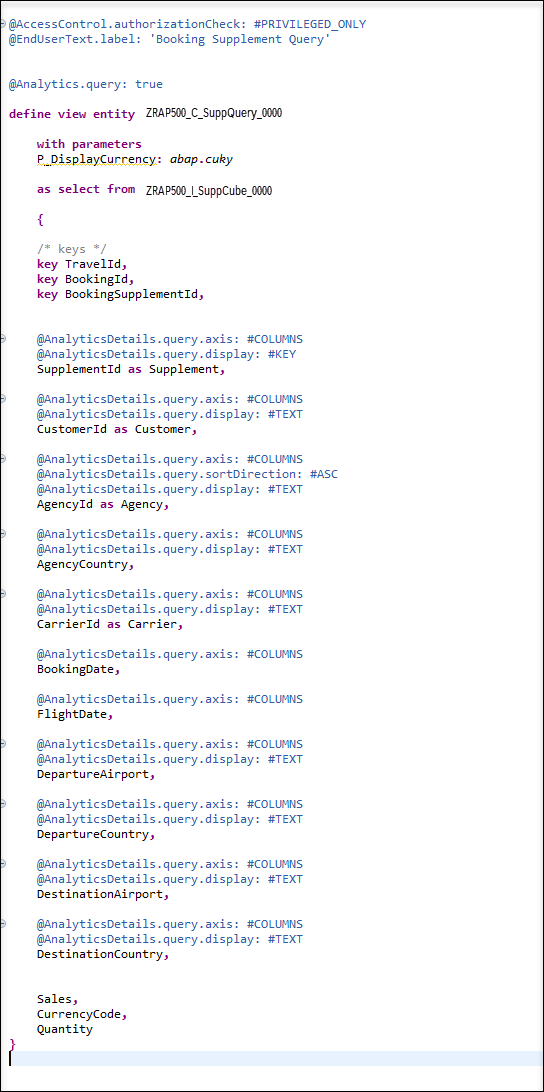
-
Define a currency conversion with a fixed reference date (‘20200101’) based on the Sales attribute.
@EndUserText.label: 'Sales' @AnalyticsDetails.query.axis: #ROWS @Semantics.amount.currencyCode: 'DisplayCurrency' @Aggregation.default: #SUM // requires @Aggregation.default: #FORMULA on 2105 systems currency_conversion ( amount => Sales, source_currency => CurrencyCode, target_currency => $parameters.P_DisplayCurrency, exchange_rate_date => cast ('20200101' as abap.dats), exchange_rate_type => 'M' ) as SalesInDispCrcy,Currency conversion could also be defined on the cube level, however, then it would be applied to all selected rows instead of the final (aggregated) result, usually having lower performance.
-
Use the view parameter to define the Display Currency attribute with a default value ‘USD’ (US Dollar)
@Consumption.defaultValue: 'USD' @EndUserText.label: 'Display Currency' $parameters.P_DisplayCurrency as DisplayCurrency, - expose the quantity measure.
@AnalyticsDetails.query.axis: #ROWS @Aggregation.default: #SUM Quantity, -
define a calculated measure Average Sales using a formula
The expression
1 as AverageSalesis required to create an attribute which carries the result of the formula (the number ‘1’ has no semantics).@EndUserText.label: 'Average Sales' @AnalyticsDetails.query.axis: #ROWS @Aggregation.default: #FORMULA @AnalyticsDetails.query.formula: '$projection.SalesInDispCrcy / $projection.Quantity' 1 as AverageSales - Save and activate the dimension view.
-
Your final code should look like the following:
ZRAP500_C_SuppQuery_####Copy
@AccessControl.authorizationCheck: #PRIVILEGED_ONLY @EndUserText.label: 'Booking Supplement Query' @Analytics.query: true define view entity ZRAP500_C_SuppQuery_0000 with parameters P_DisplayCurrency: abap.cuky as select from ZRAP500_I_SuppCube_0000 { /* keys */ key TravelId, key BookingId, key BookingSupplementId, @AnalyticsDetails.query.axis: #COLUMNS @AnalyticsDetails.query.display: #KEY SupplementId as Supplement, @AnalyticsDetails.query.axis: #COLUMNS @AnalyticsDetails.query.display: #TEXT CustomerId as Customer, @AnalyticsDetails.query.axis: #COLUMNS @AnalyticsDetails.query.sortDirection: #ASC @AnalyticsDetails.query.display: #TEXT AgencyId as Agency, @AnalyticsDetails.query.axis: #COLUMNS @AnalyticsDetails.query.display: #TEXT AgencyCountry, @AnalyticsDetails.query.axis: #COLUMNS @AnalyticsDetails.query.display: #TEXT CarrierId as Carrier, @AnalyticsDetails.query.axis: #COLUMNS BookingDate, @AnalyticsDetails.query.axis: #COLUMNS FlightDate, @AnalyticsDetails.query.axis: #COLUMNS @AnalyticsDetails.query.display: #TEXT DepartureAirport, @AnalyticsDetails.query.axis: #COLUMNS @AnalyticsDetails.query.display: #TEXT DepartureCountry, @AnalyticsDetails.query.axis: #COLUMNS @AnalyticsDetails.query.display: #TEXT DestinationAirport, @AnalyticsDetails.query.axis: #COLUMNS @AnalyticsDetails.query.display: #TEXT DestinationCountry, @EndUserText.label: 'Sales' @AnalyticsDetails.query.axis: #ROWS @Semantics.amount.currencyCode: 'DisplayCurrency' @Aggregation.default: #SUM // requires @Aggregation.default: #FORMULA on 2105 systems currency_conversion ( amount => Sales, source_currency => CurrencyCode, target_currency => $parameters.P_DisplayCurrency, exchange_rate_date => cast ('20200101' as abap.dats), exchange_rate_type => 'M' ) as SalesInDispCrcy, @Consumption.defaultValue: 'USD' @EndUserText.label: 'Display Currency' $parameters.P_DisplayCurrency as DisplayCurrency, @AnalyticsDetails.query.axis: #ROWS @Aggregation.default: #SUM Quantity, @EndUserText.label: 'Average Sales' @AnalyticsDetails.query.axis: #ROWS @Aggregation.default: #FORMULA @AnalyticsDetails.query.formula: '$projection.SalesInDispCrcy / $projection.Quantity' 1 as AverageSales }
- Step 15
Similar to the SAP Fiori Elements preview which is offered for OData V2 UI and OData V4 UI service bindings there is now an Analytical Data Preview available. This can be used by the ABAP developer to test the implementation of an Analytical Query since the preview uses the InA protocol.
Now that you have created the query it is possible to use a data preview to test our implementation.
- Navigate to the folder Data Definition
- Right click on the query
ZRAP500_C_SuppQuery_####and select Open with > Data Preview
-
A new browser tab will open and you might have to authenticate using the credentials of your SAP BTP ABAP environment system.
-
Choose US Dollar as Display Currency with clicking OK.

-
You can see the data that has been retrieved using the InA-Protocol.

- Step 16
You need to create an access control DCL0 for booking supplement query to block all unprivileged access (SQL queries return 0 rows).
Use “Standard” DCL (aka DCL0) to make the protected CDS view return 0 results.-
Right click your package > New > Other ABAP Repository Object > search for Access control and click Next

-
Enter the following values and press Next.
- Name:
ZRAP500_C_BOOKINGQUERY_#### - Description:
access control for query - Referenced Object:
ZRAP500_C_SuppQuery_####(Your created query)

- Name:
-
Select a transport request and press Finish.
-
Remove lines 9 and 10 and enter false.

-
Save and activate your access control.
- Your final code should look like the following: ZRAP500_C_BOOKINGQUERY_####Copy
@EndUserText.label: 'Disallow access to Booking Supplement Q' @MappingRole: true define role ZRAP500_C_BOOKINGQUERY_#### { grant select on ZRAP500_C_SuppQuery_#### where false; }
-
- Step 17
You use a service definition to define which data is to be exposed as a business service, using one or more business service bindings.
-
Right-click your created query and choose New Service Definition.

-
Enter the following values and press Next.
- Name:
ZRAP500_C_SupplmntService_#### - Description:
Booking Supplement Analysis Service - check if Exposed Entity is your created query
ZRAP500_I_SUPPQUERY_####

- Name:
-
Select transport request and press Next.
- Select the template Define Service and press Finish.
- After the query is exposed as a service it must be activated by pressing Ctrl+F3

-
- Step 18
The service binding is used to bind a service definition to a communication protocol and in our case, the protocol that enables web-based data access from ABAP systems is the Information Access (InA) protocol.
-
Right click your newly created service definition and choose New Service Binding.

-
Enter the following values and press Next
- Name:
ZRAP500_UI_SuppIna_#### - Description:
Booking Suplement Query Service Binding - Choose InA - UI as Binding Type
- Check if the service definition
ZRAP500_C_SUPPLMNTSERVICE_####which you created before, is listed in the field Service Definition.

- Name:
-
Choose a transport request and click Finish.
- Activate your service binding.
- After activation, the external service name for your query is displayed.

The analytical query will be displayed with the external service name in SAP Analytics Cloud as the data source.
-
- Step 19
-
Right-click your package, choose New > Other ABAP Repository Object.

-
Search for IAM App under Cloud Identity and Access Management. Click Next.

-
Enter the following values and press Next
- Name:
ZRAP500_SUPPLEMENTIAM_#### - Description:
IAM App for Booking Supplement Query - Choose EXT-External App as Application Type and click Next

- Name:
-
Choose a transport request and click Finish.
Your created IAM App name will get an EXT automatically in his name like:
ZRAP500_SUPPLEMENT_####_EXT.
-
Go to the Services tab and click on insert button.

-
Select Service Type as
InA - UIand your Service Name which is your service binding nameZRAP500_UI_SUPPLEMENT_####. Click OK.
-
Save and activate your App.
-
You need to Publish Locally this IAM App.

-
- Step 20
-
Right-click your package, choose New > Other ABAP Repository Object and search for Business Catalog.
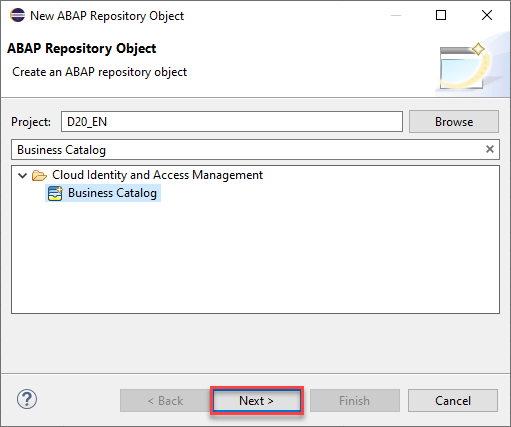
-
Enter the following values and press Next
- Name:
ZRAP500_BUSINESS_CATALOG_#### - Description:
Business catalog

- Name:
-
Choose a transport request and click Finish.
-
To create a Business Catalog App Assignment, in your created Business Catalog click Apps, click Add, assign your previously created external IAM app as IAM App and click Next.

-
Choose a transport request and click Finish. The Business Catalog App Assignment will be opened.

-
Back to the Business Catalog, choose your Assignment ID and click Publish Locally.

-
- Step 21
-
Login to the Fiori launchpad and open Maintain Business Roles App under Identity and Access Management.

-
Navigate to the
SAP_BR_DeveloperRole, select Assign Business Catalogs and click Edit.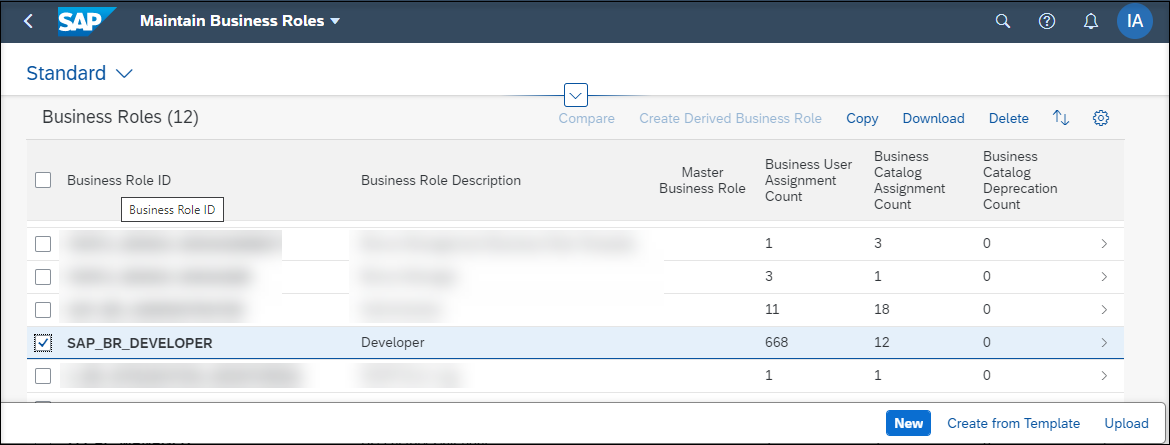

-
Click Add and find your business catalog in the popup and click OK to add the business catalog.


-
Check in the Assigned Business Catalogs, if your business catalog is added in the list. Click Save.

-
- Step 22
-
Back to the main page of Fiori launchpad and open Communication Systems App under Communication Management.

-
Click New to create a new communication system. Enter System ID and System Name, click Create.

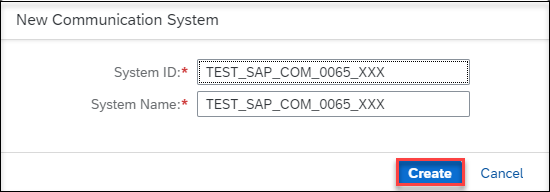
-
The new communication system will be opened. Switch Destination Service to OFF and now enter you SAP Analytics Cloud host name (ex:
###.cloud.sap) as Host Name and443as Port. Click Save.
-
Back to the Communication Management and open Communication Arrangements to create a new one.

-
Click New and select
SAP_COM_0065as Scenario.Enter a name for your communication arrangement and click Create.
-
The new communication arrangement will be opened. Choose the communication system which you created previously in the Communication System field. Provide the Tenant ID of your SAP Analytics Cloud tenant.

Tenant ID can be found under the main menu of the SAP Analytics Cloud tenant, click System > About > System Name.
-
Under the Outbound Services, the service status for UI Link Navigation should be checked as Active and Retrieve Stories should be unchecked, click Save.

-
- Step 23
-
Login to the SAP Analytics Cloud tenant.

-
Open the main menu and click Connection and on the Connection Window click Add. In the popup under Connect to Live Data click SAP S/4 HANA.


-
In the New S/4 HANA Live Connection dialog enter Name and Description, Connection Type has to be Direct, for Host copy your Fiori launchpad link like
###.abap-web.stagingaws.hanavlab.ondemand.com. Enter443in HTTPS Port field, and100for Client. As Authentication Method choose SAML Single Sign-on (Standard Compliant). Click OK.
-
check the result.

-
- Step 24
Models transform your raw data into useful information that can then be used to create dynamic visualizations. Since you will use the unique feature Live Data Connection SAP Analytics cloud will create the model based on the analytical query that you have created and published in the previous exercise. Based on such a model you can perform online analysis without the need of data replication.
-
Expand navigation bar, choose Modeler and Click Live Data Model .


-
In the popup choose SAP BW for System Type. Choose your created connection in the last step as Connection.Choose your created connection in the last step as Connection and if needed login with your username and password in the second popup.

-
Expand Data source and select your created Query in the last exercise as Data Source.

-
Click OK to continue.
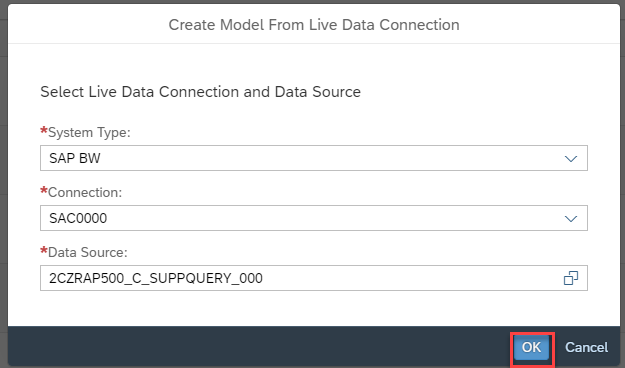
-
In the model you can check all Measures and dimensions which are from
@EndUserText.labelannotations.

-
Save the new model and enter the following values and click OK:
- Name:
ZRAP500_#### - Description:
Model ####

- Name:
-
Check your model in the Modeler page.

-
- Step 25
A story is a presentation-style document that uses various elements such as charts, images or tables to visualize your data.
Adding a chart starts with picking a chart type. Then you select your model and add measures and dimension and start on working how the data is displayed. Here you will create a story including a chart, a table and a Donut chart.Open a blank dashboard
-
Expand navigation bar and click Stories and choose Dashboard as your template.


-
A Blank Dashboard will be opened.

-
Enter a Dashboard Title like
RAP500_####.
Insert Charts
-
To insert a chart, click on the chart icon in the task menu and select your model with double clicking your model.

-
Set Currency as US Dollar with clicking Set.

-
You can move the chart with click and drag around the page. After you found a place for your chart, you need to add some measures and dimensions, which should be shown on the chart. You will find all settings on the right hand side under Builder.

-
Open + Add Measure and choose Sales.

-
Open + Add Dimension and choose Product. Now there is a chart which shows how the sales are distributed in different products.

-
SAP Analytics Cloud can read the text fields defined in the supplement dimension with annotation
@ObjectModel.text.association: '_SupplText'and therefore the product names from supplement cube with the annotation @EndUserText.label: ‘Product’
-
To insert another chart with a different structure, click on the chart icon in the task menu, click Comparison and choose Waterfall.

-
Choose a measure (Average Sales) and a dimension (Agency) for your chart.

-
SAP Analytics Cloud can read the text fields defined in the query with annotation @AnalyticsDetails.query.display: #TEXT.

Insert indicator
-
Click the chart icon in the task menu, click Indicator and choose Numeric Point.

-
Choose Average Sales as Primary Values under Measures.

-
You will find the calculated measure in this chart.

Save the Story
-
You are almost done with your story, you need just to save the story. Click on save icon and choose Save.
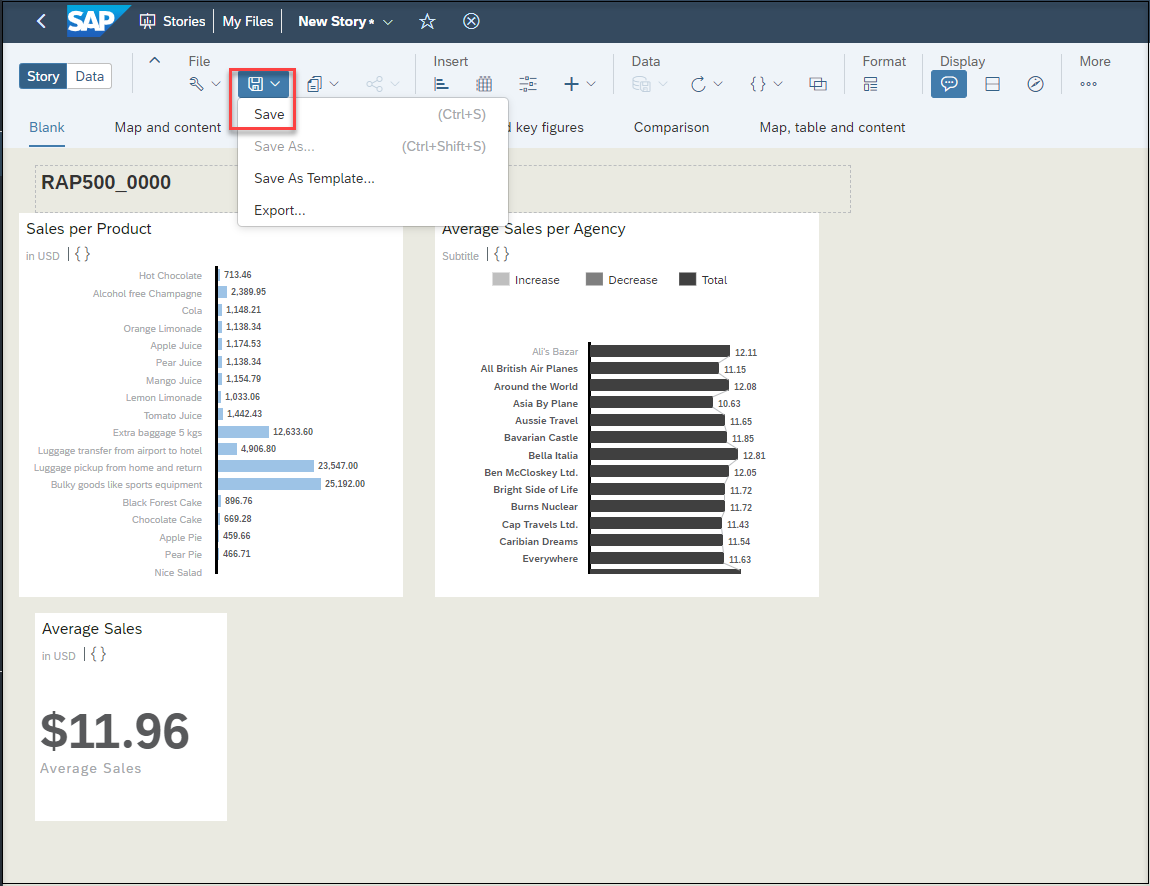
-
Enter following values and click OK
- Name:
RAP500_####_Story - Description:
Story ###

- Name:
-
You will find your new created story under Welcome to Stories.

You have used the preconfigured connection of the SAP Analytics Cloud instance to connect to the SAP BTP ABAP environment system where you have developed an Analytical Query. The data was retrieved using a Live Data Connection so that any change in the data was immediately reflected in the visualization of your query in SAP Analytics Cloud.
-
- Step 26
You can create more different and complicated analytics charts and tables with your query. Here there is some more examples.
-
Click the chart icon in the task menu, click Trend and choose Line.

-
Choose Average Sales and Sales as left and right axis and Booking Date as dimension. You can change the color of axis and make the chart bigger or move it around your dashboard.

-
Click again chart icon in the task menu, click Correlation and choose Cluster Bubble

-
Choose Sales as Measure, Product as Dimension and Agency Country as Color. You can make a filter on agency country and choose some of countries for your chart. You can change the color of your chart as well.
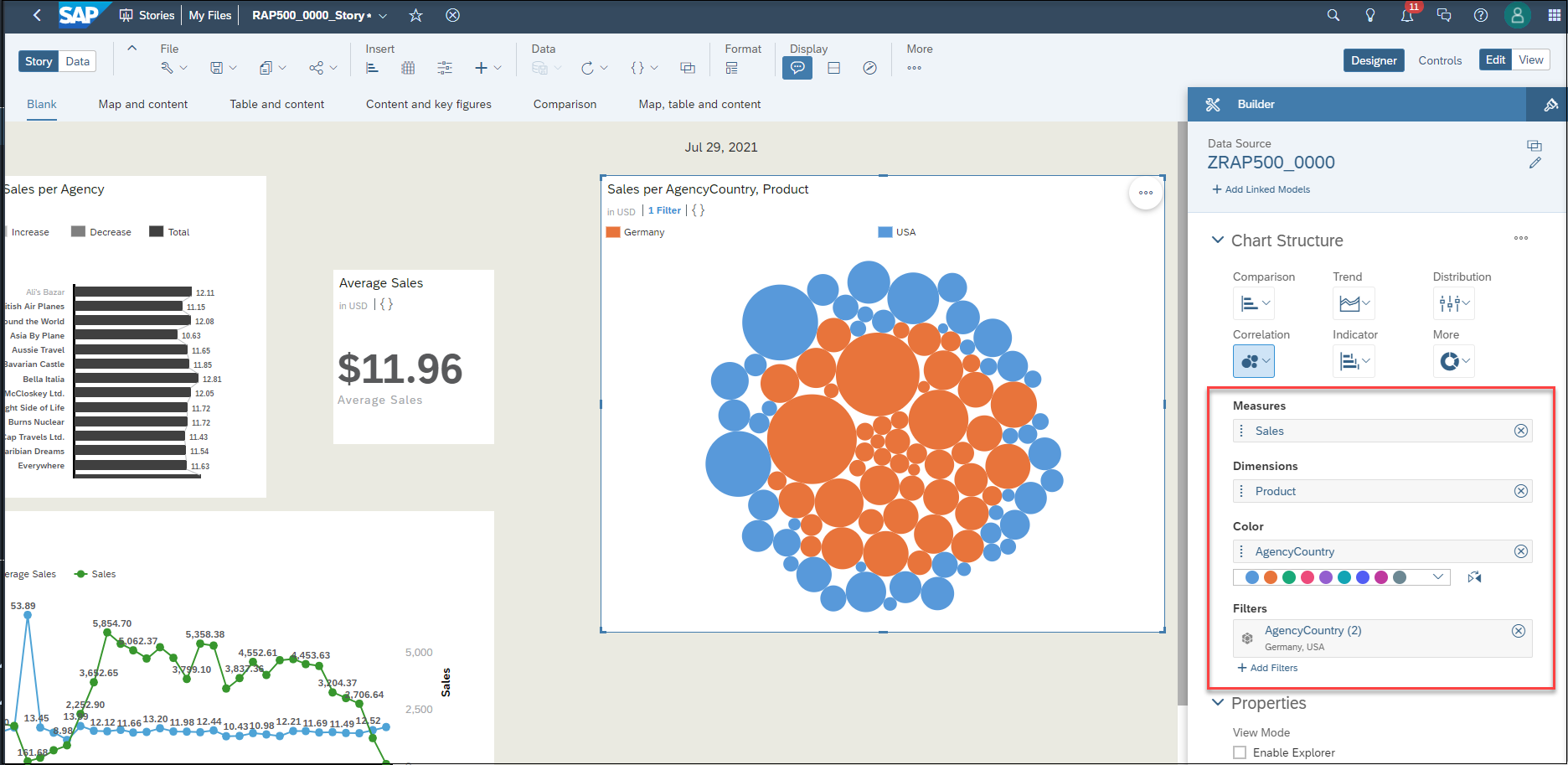
In this chart you can find out how much of a product has been sold in a country and you can find the more sold products in each country.
-
Do not forget to save your story.

-
- Step 27
Which connection type did you used in the SAP Analytics Cloud?
- Overview
- Import templates for Analytical CDS views
- Create dimension for Agency
- Edit dimension view
- Create dimension for Airport
- Create dimension for Carrier
- Create dimension for Booking
- Create dimension for Connection
- Create dimension for Customer
- Create dimension for Supplement
- Create Supplement text view
- Create Booking Supplement interface view
- Create Booking Supplement Cube
- Create Booking Supplement Query
- Data preview
- Access Controls
- Create service definition
- Create InA UI service binding
- Create IAM App
- Create business catalog
- Add business catalog to developer business role
- Create communication system and arrangement
- Connect the ABAP system to SAP Analytics Cloud
- Create model
- Create Story
- More analytics charts and tables
- Test yourself